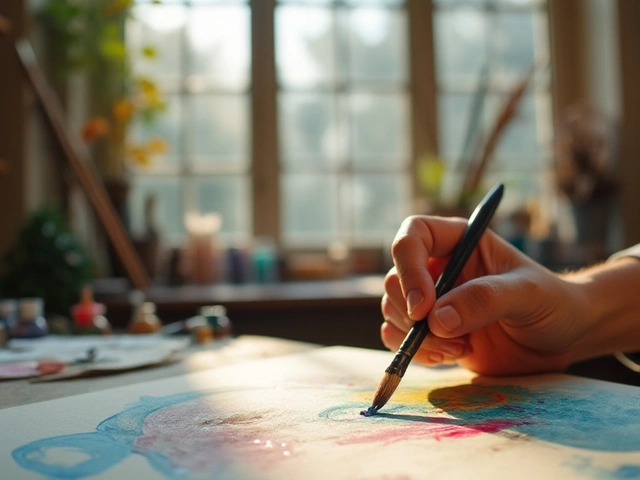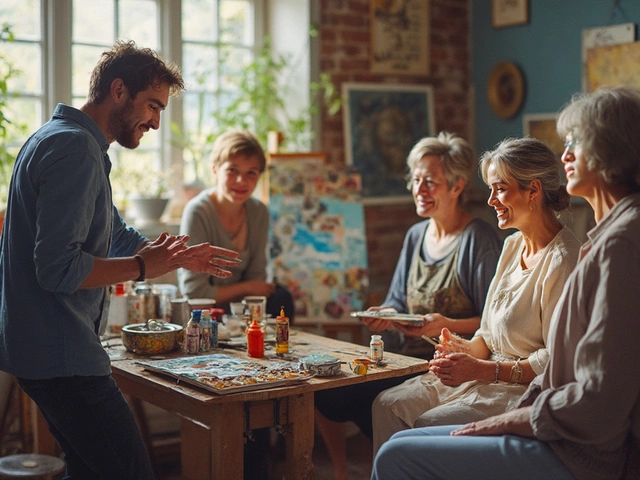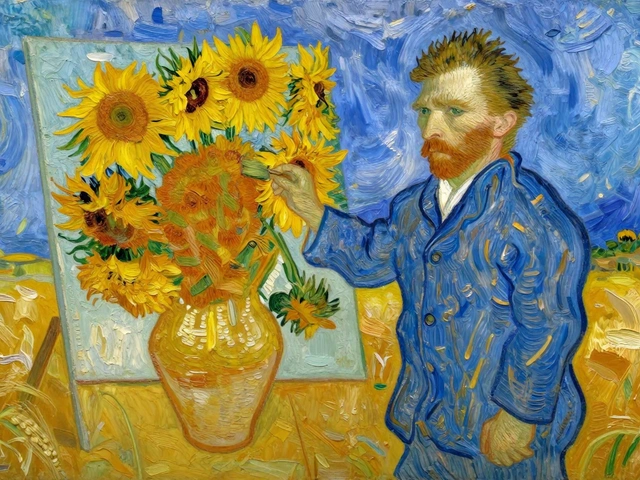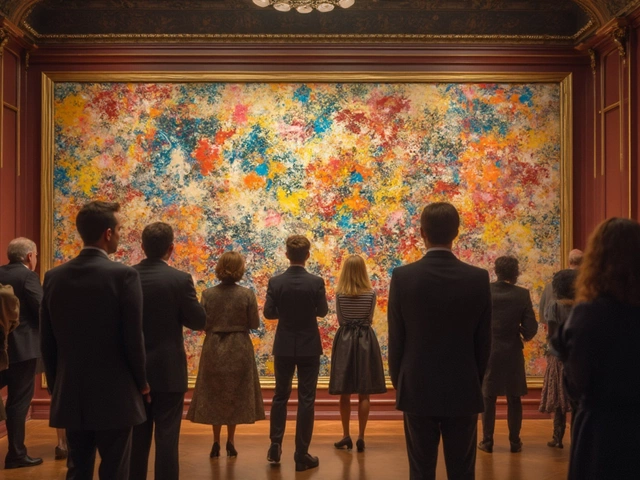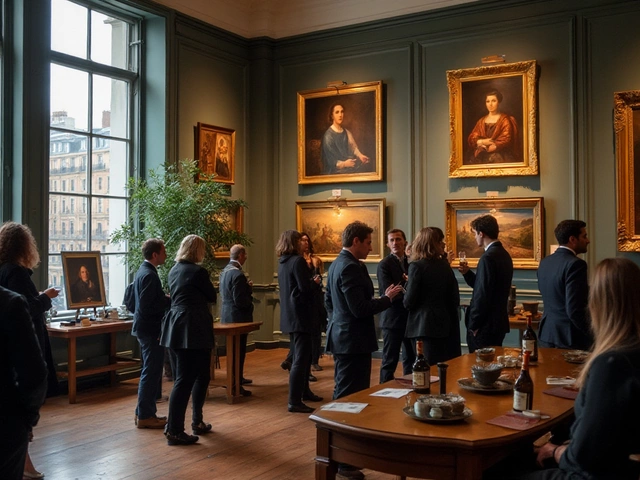So, you've been dreaming of seeing your artwork showcased in a gallery, but where do you even start? Let's get real — it's not just about painting a masterpiece and hoping for the best. It's about strategic moves and knowing how to navigate the art world. First off, understand what galleries are really looking for. They want originality, yes, but they also need to see a professional attitude in an artist who’s consistent and reliable.
Your portfolio is like your calling card. It's got to shine. Curate it carefully with only your best pieces, and make sure it shows your range without being all over the place. Think quality over quantity, and keep it updated — nothing screams 'amateur' like outdated work. Consider hiring a professional to photograph your pieces; it makes a world of difference.
- Understanding Gallery Expectations
- Creating a Compelling Portfolio
- Networking and Building Relationships
- Participating in Art Fairs
- Leveraging Online Platforms
- Staying Persistent and Resilient
Understanding Gallery Expectations
Alright, let's crack the code on what art galleries actually want. You're an artist, they're a business, and this relationship needs to make sense for both sides. First and foremost, galleries look for authenticity and a coherent style. Your work should tell a story or convey a message beyond just being pretty. Quirky, bold, or emotionally impactful - make sure it stands out.
Consistency in your work is critical. Galleries want to know they can rely on you to deliver a particular quality and style, which helps them market your pieces to collectors. Nobody wants to put effort into promoting an artist who changes their style every other month.
Quality Over Quantity
Here's a tip: focus on the quality of your work rather than churning out hundreds of pieces. Galleries can spot superficial work from a mile away and they’d rather see a few masterpieces than a swarm of mediocre attempts.
The Business Aspect
Understand this: galleries need to sell your work to stay in business. They look at your marketability, which involves media presence and how your work resonates with their client base. Basically, they’re asking, 'Can we sell this?' before they consider anything else. Social media following can help demonstrate your appeal but don't worry if you're not Insta-famous just yet. Engage genuinely with art communities online, and build a presence.
| Expectation | Explanation |
|---|---|
| Originality | Something unique and distinct that sets your work apart. |
| Consistency | A steady style and quality that galleries can rely on. |
| Marketability | The potential to attract buyers and the ability to promote. |
A little note on rejection: don't take it personally. Galleries get approached by countless artists. If they say no, it's not necessarily your work that's problematic. It might not fit their current theme or clientele. Use the feedback to improve and keep showing up. Persistence often pays off in this field.
Creating a Compelling Portfolio
Putting together a portfolio that's going to catch a gallery's attention isn't just about having talent—it's also about presentation and focus. Your portfolio needs to be a true representation of your artistic voice and should clearly reflect your style as an artist.
Choosing the Right Pieces
First things first, be selective. A common mistake is stuffing your portfolio with too many works. Think of it like a highlight reel—you want to show your best, not everything you've ever created. Pick pieces that demonstrate diversity as well as consistency in theme or technique.
Professional Presentation
How your work is presented can make or break that first impression. Invest in high-quality photographs of your artwork. Poor quality images won't do your work justice. Consider professional photography if your budget allows. Ensure proper lighting and minimal glare.
Organizing Your Portfolio
An organized portfolio speaks volumes about your professionalism. Here’s a simple structure you might consider:
- Introduction: A brief artist statement that highlights your vision and what shapes your creative process.
- Artwork Sections: Group your work into logical sections if applicable, such as themes, mediums, or series.
- Details: Each piece should have a title, dimensions, medium used, and year created. Galleries appreciate this context.
Digital Considerations
In today’s digital age, a strong online presence is part of any artist's toolkit. Having a digital portfolio is as important as a physical one. Use platforms like Behance or create a personal website showcasing your art exhibitions history and contact details.
Tweaking and Updating
A portfolio is never truly finished. Update it regularly as your work evolves. It's also wise to tailor it slightly if you’re applying to specific art galleries. This doesn’t mean redoing the whole thing, but a few personalized adjustments here and there can speak volumes.
Networking and Building Relationships
When it comes to getting recognized by art galleries, who you know can be just as important as what you create. Networking might sound like a buzzword, but it’s truly one of the most powerful tools you’ve got. Building relationships in the art world can open doors you didn't even know existed.
Attend Events
Art events are your playground. These are opportunities to meet gallery owners, curators, and fellow artists. Don’t just hover in the background; introduce yourself, ask questions about the gallery, and share a little about your work. It’s not about pushing your work aggressively, but about making genuine connections. Attendees often remember a face and a good conversation over a quick business pitch.
Local Art Community
Get involved with your local art community. Whether it's joining an artist group or participating in open studios, the local scene is a great starting point. Skipping these steps is a common mistake for emerging artists. Local galleries often check out nearby artists first, so get on their radar.
Use Social Media
Never underestimate the power of social media platforms. They're a treasure trove for showcasing your art and connecting with people across the globe. Use them to engage with galleries, share your process, and participate in art challenges. Just remember to keep it professional; your online presence says a lot about you.
Follow-Up
Met someone interesting at an event? Follow up! Send a short email saying how nice it was to meet them and reference your conversation so they remember you. It's these subtle touches that keep you in people's minds.
Remember, it’s all about persistence paired with authenticity. Relationships take time to build, but once formed, they can be the pathway to long-term success in the art exhibitions realm.
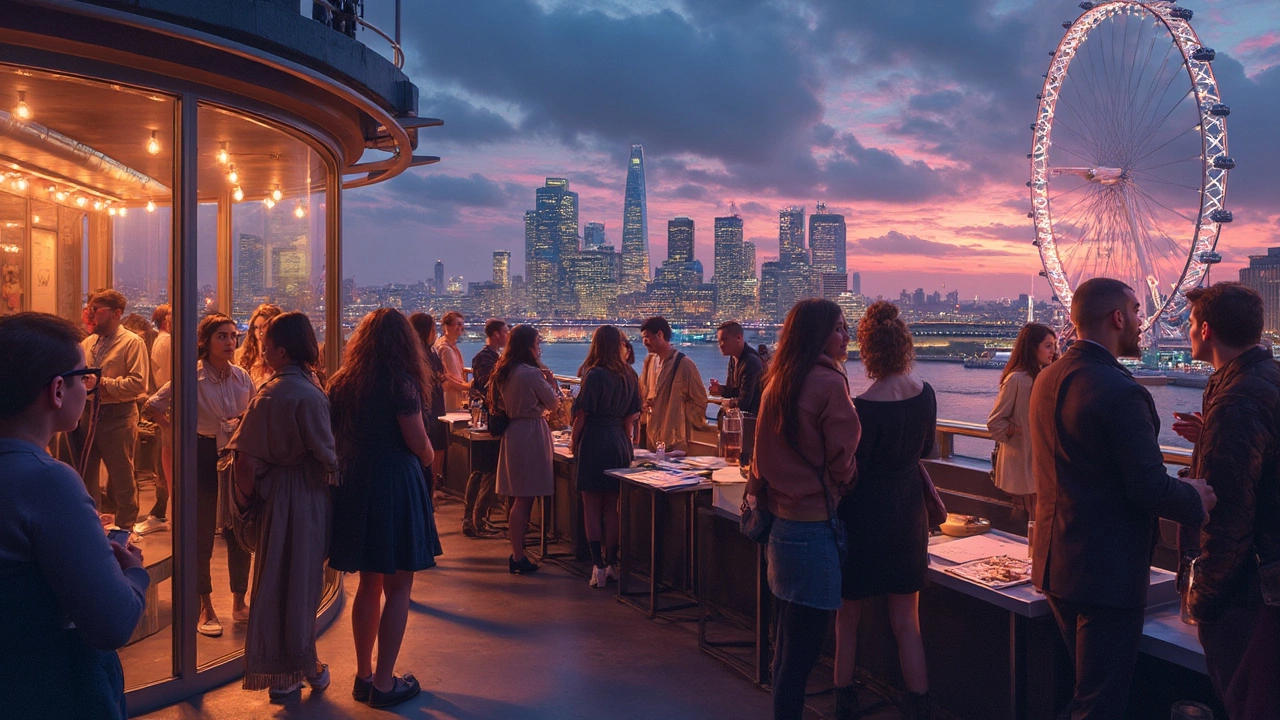
Participating in Art Fairs
Jumping into the world of art fairs is like diving into an ocean of opportunity. These events bring together artists, collectors, gallery owners, and art enthusiasts from all over. They offer you a chance to get your work noticed by the right people and maybe even land a spot in those coveted art galleries.
First things first, you need to choose the right art fair. Not every fair will suit your style or your work's theme. Some focus more on modern art, while others might lean towards classical styles. Do your homework: check their previous participants, visit their past events if you can, and get a feel for the crowd and the kind of art that's shown.
Preparation is Key
When you've decided on a fair, preparation is key. Start with a budget - fairs can be costly. You'll need to consider fees for booth space, travel, accommodation, and the shipping of your artwork. Some fairs might have restrictions or requirements for display, so read the instructions carefully.
Here's a handy checklist for prepping your stand:
- High-quality labels for your pieces, including your name, title of the artwork, and price.
- Back-up materials like nails, hammer, and any tools for last-minute adjustments.
- Business cards or a digital way (like a QR code) for visitors to grab your contact info easily.
- An artist statement that’s clear and concise. It should explain your inspiration and the story behind your works.
Engage and Network
Once the fair is in full swing, it's not time to sit back and relax. Be proactive and engage with visitors. Networking here is crucial. You never know if the person casually strolling past your booth runs a major art gallery or is a potential buyer willing to invest in your future exhibitions.
Introduce yourself confidently, talk about your work with passion, and keep conversations natural. If you see someone lingering at your booth, ask them what they think; it's a great conversation starter.
Following Up
After the fair, follow up with every meaningful connection you made. Send a thank-you email, connect on social media, or even consider sending a small postcard of one of your works. It keeps you on their radar and shows that you're serious and professional about your art career.
Remember, getting recognized by art galleries through fairs doesn't happen overnight. Patience and persistence are just as important as the art you create. Keep participating, learning, and growing from each experience.
Leveraging Online Platforms
In today's digital age, if you're not online, you're basically invisible, especially in the art world. Getting your work recognized by art galleries often requires a mix of physical presence and strong online engagement. Let's figure out how to effectively use the internet to get your art in front of the right eyes.
Join Art Networks
Platforms like Artsy, DeviantArt, and ArtStation are hubs for artists to showcase their work to a global audience, including gallery curators who are always on the lookout for fresh talent. Sign up, keep your profile professional, and actively engage with other artists and potential buyers.
Social Media Matters
Instagram is a big deal for artists. It’s visual, direct, and a perfect place to show off your art. Make sure your feed is cohesive and tells your story. Use hashtags wisely, like #artgallery and #artistsoninstagram, to get discovered by those seeking new art.
Build Your Website
Think of your website as your online portfolio. A neat, mobile-friendly site with high-res images of your work, an updated bio, and contact info is crucial. Include a blog to share insights and experiences, keeping visitors coming back.
Keep Up with Trends
Being aware of what’s trending in the art world can give you an edge. NFT art is a hot topic right now, and some galleries are exploring these digital assets. Staying informed can help you position your art in a way that resonates with contemporary collectors and galleries.
Email Newsletters
A regular newsletter keeps your audience engaged and updated. Share upcoming exhibitions, new works, and personal insights. Make it easy for readers to forward to friends, expanding your reach organically.
Here's a quick look at some top platforms and their features:
| Platform | Features |
|---|---|
| Visual storytelling, diverse user base, hashtag discovery | |
| Artsy | Art marketplace, gallery connections, educational resources |
| ArtStation | Portfolio showcase, artist collaborations, project opportunities |
Using these online platforms effectively can make all the difference in getting your art noticed by art galleries. Consistent engagement, professional presentation, and timely updates ensure that when gallery owners browse the web, your work pops up in all the right places.
Staying Persistent and Resilient
Getting recognized by art galleries isn't a one-time effort; it's more like a marathon that requires persistence and a whole lot of resilience. Every artist faces rejection, and it can feel like a punch to the gut. But those who push through these setbacks are the ones who eventually break through. Let's talk about how you can keep your spirits high and your goals clear.
First, remember that timing is everything. Your art might just not fit a gallery's current focus or theme. It's not always about the quality of your work. Keeping tabs on different galleries, understanding their cycles, and revisiting them with new angles can keep you on their radar.
Keeping a Growth Mindset
Your mindset is your ally in this journey. Each piece of feedback, even if it feels harsh or blunt, should be taken as constructive. Embrace it, learn from it, and let it fuel your improvement. This growth mindset transforms rejections into opportunities to refine your craft.
Building Relationships
Networking is key in the art world. Building genuine relationships with gallery owners, curators, and even fellow artists can open doors that might otherwise remain locked. Attend art openings, participate in community events, and engage actively on social media. Show genuine interest in others' work; be generous with your support and it'll often be reciprocated.
Consistency is Key
Staying on course means consistently working on your art and putting it out there. Even when it feels like progress is slow, each step — whether it's a new connection or an improved technique — adds up. Small, regular progress is better than sporadic bursts.
Learning from the Best
Study the journeys of artists who have made it. Many successful artists faced years of rejection before making a breakthrough. Understanding their paths can provide insights and encouragement. Sometimes, seeing that others have walked this rugged road and succeeded can be the motivation you need to keep going.
Financial Resilience
The financial aspect of keeping an art career afloat can't be ignored. Diversify your income streams whenever possible. Teaching workshops, selling prints, or taking on commission work can help ease the financial pressure while you pursue gallery recognition.
Tracking Progress
| Month | Actions Taken | Outcomes |
|---|---|---|
| January | Portfolio Update, 5 Gallery Submissions | 2 Positive Responses |
| February | Attended 3 Art Events, Networked with 5 Curators | 1 Exhibition Offer |
Remember, the pathway to recognition in the art world is paved with persistence. Keep refining, keep connecting, and most importantly, keep creating. Your moment will come, but only if you stay the course.

